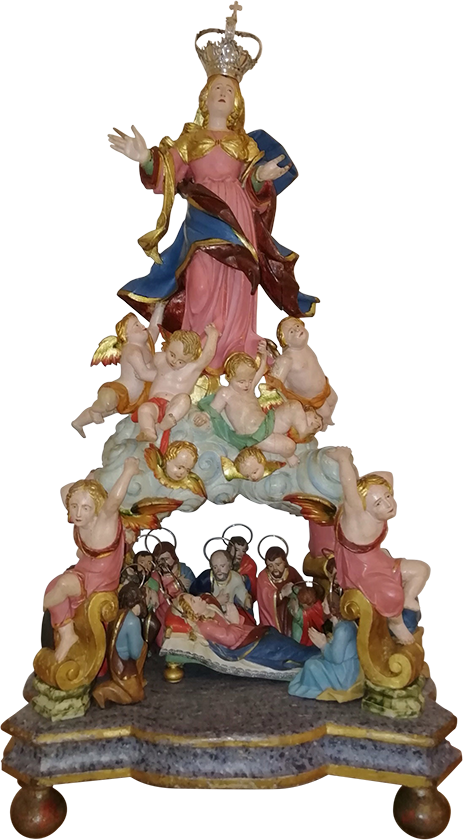This sculptural ensemble harmoniously portrays the Death and Assumption of Our Lady. It is composed of two levels. In the foreground, Our Lady is pictured lying on her back, sleeping, with her hands on her chest, resting on a reclining couch, with a headrest at one end, a white pillow and red cushion, surrounded by eleven apostles.
Our Lady has golden hair, which falls in two loose plaits, framing her face and leading down to the right side of her chest; she wears a white veil over her face, a pink tunic with long sleeves that cover her body and a blue cloak that covers her left breast and shoulder, passing around her back to wrap around her right arm and cover her legs and feet.
The apostles, with halos above their heads, kneeling with their hands on their chests, leaning in veneration and affection upon the Virgin, wear red, pink, blue or brown cloaks over blue, green, pink, white, or red tunics.
The background is composed of a pale blue cloud, held up by four caryatids and with the winged faces of five angels. Our Lady sits majestically on the cloud, her arms extended and hands open, eyes towards the sky, lifted by five winged angels.
The Virgin Mary, with golden hair in long, loose plaits, wears a long purple tunic and gold cloth wrapped around her chest and right arm, under a blue cloak, with golden hems, which loosely falls from her left shoulder and floats in the wind.
An interesting element of the piece described is the combination of two moments from the life of Our Lady: asleep or dead; and the Assumption.
According to the artist, all the apostles (did he exclude Judas?! – only eleven feature in the painting?!…) would have witnessed the passing of Our Lady, from life on earth, to the visible company of the Trinity. In the Scriptures, as we know, this fact is not confirmed.
Nevertheless, it is still indicative to underline the apostles’ affection for Our Lady and their presence at such a significant moment.
With regard to the Assumption of Our Lady, it is now a dogma of the Church, proclaimed by Pope Pius XII in 1950. Mary was lifted in body and soul to the glory of heaven. She enjoys the fullness of redemption. God didn’t want her, who bore the Lord of life, to know the corruption of the tomb. United with Jesus in suffering and in death, directly connected to Jesus in the mystery of redemption, Mary is now with the resurrected and glorified Christ, exalted by God as Queen, waiting for us and interceding for us. She is proof that man will triumph over death. And, being in heaven, she proves that… eternal blessedness is possible!
“The book tells the history of the city of Braga in five parts, the same as the number of floors in the Monument named “Our Lady of the Tower”.
It begins at the time of the Bracari, followed by the Suevi, the Visigoths and Arabs; on the second floor (second chapter), we travel through the Middle Ages, when the Archdiocese was restored around its most iconic building: the Cathedral; then comes the Renaissance, with important reflections in Braga; new spaces are opened for this section and renovated in the seventeenth and eighteenth centuries, highlighting the risks of André Soares and Carlos Amarante; and the final chapter focuses on current times.
Paulo Abreu
